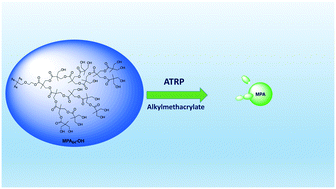当前位置:
X-MOL 学术
›
Mol. Syst. Des. Eng.
›
论文详情
Our official English website, www.x-mol.net, welcomes your feedback! (Note: you will need to create a separate account there.)
Molecular design and shear stability correlations of dendritic polymethacrylates†
Molecular Systems Design & Engineering ( IF 3.6 ) Pub Date : 2019-10-03 , DOI: 10.1039/c9me00081j Lelia Cosimbescu 1, 2, 3 , Deepika Malhotra 1, 2, 3 , Kristen B. Campbell 1, 2, 3 , Marie S. Swita 1, 2, 3 , Zachary C. Kennedy 1, 2, 3
Molecular Systems Design & Engineering ( IF 3.6 ) Pub Date : 2019-10-03 , DOI: 10.1039/c9me00081j Lelia Cosimbescu 1, 2, 3 , Deepika Malhotra 1, 2, 3 , Kristen B. Campbell 1, 2, 3 , Marie S. Swita 1, 2, 3 , Zachary C. Kennedy 1, 2, 3
Affiliation

|
Highly branched poly(alkyl methacrylate)s with and without crystalline polycaprolactone segments were designed and prepared via a core-first strategy from commercially available hyperbranched cores, then evaluated with respect to their rheology and shear stability performance. The main focus of this work was to study the effect of branching on mechanical shear stability, as it relates to the durability of viscosity index improvers. A secondary goal was to study the influence of the side chain length and polycaprolactone segment on rheology and shear stability. The polymers were prepared from 16, 32, 64-arm functionalized macroinitiators then subsequently subjected to ARGET-ATRP (activator regenerated by electron transfer – atom transfer radical polymerization) conditions with dodecyl methacrylate (DMA) or 2-ethylhexyl methacrylate (EHMA). The inclusion of polycaprolactone appears to have enhanced the viscosity index in several samples. Although hyperbranching is thought to increase shear stability, several analogs provided competitive viscosity index (VI) values as well. The caprolactone (CL) hard segments appeared to have a detrimental effect on shear, as compared to their non-CL counterparts. Surprisingly, EHMA showed decreased shear stability versus DMA analogs, despite the shorter polymer side chain (C6 versus C12) and presumably less side-chain entanglements. Overall, the trend is very clear for non-CL polymers, with shear stability increasing as arm number increased from 16, to 32 to 64, despite the substantial increase in molecular weight.
中文翻译:

树枝状聚甲基丙烯酸酯的分子设计和剪切稳定性相关性†
高度支化的聚(烷基甲基丙烯酸酯)与不结晶聚己内酯链段被设计和制备通过一个核-第一商购可得的超支化核,然后对其流变性和剪切稳定性进行评估。这项工作的主要重点是研究支化对机械剪切稳定性的影响,因为它与粘度指数改进剂的耐久性有关。第二个目标是研究侧链长度和聚己内酯链段对流变性和剪切稳定性的影响。该聚合物由16、32、64臂官能化大分子引发剂制备,然后再与甲基丙烯酸十二烷基酯(DMA)或甲基丙烯酸2-乙基己酯(EHMA)进行ARGET-ATRP(通过电子转移-原子转移自由基聚合再生的活化剂)条件。在一些样品中,聚己内酯的加入似乎增加了粘度指数。尽管认为超支化可提高剪切稳定性,但一些类似物也提供了竞争性粘度指数(VI)值。与非CL对应物相比,己内酯(CL)硬链段似乎对剪切有不利影响。出乎意料的是,EHMA表现出剪切稳定性下降与DMA类似物相比,尽管聚合物侧链更短(C6对C12)和侧链缠结可能更少。总体而言,非CL聚合物的趋势非常明显,尽管分子量显着增加,但剪切稳定性随臂数从16增加到32至64而增加。
更新日期:2019-12-02
中文翻译:

树枝状聚甲基丙烯酸酯的分子设计和剪切稳定性相关性†
高度支化的聚(烷基甲基丙烯酸酯)与不结晶聚己内酯链段被设计和制备通过一个核-第一商购可得的超支化核,然后对其流变性和剪切稳定性进行评估。这项工作的主要重点是研究支化对机械剪切稳定性的影响,因为它与粘度指数改进剂的耐久性有关。第二个目标是研究侧链长度和聚己内酯链段对流变性和剪切稳定性的影响。该聚合物由16、32、64臂官能化大分子引发剂制备,然后再与甲基丙烯酸十二烷基酯(DMA)或甲基丙烯酸2-乙基己酯(EHMA)进行ARGET-ATRP(通过电子转移-原子转移自由基聚合再生的活化剂)条件。在一些样品中,聚己内酯的加入似乎增加了粘度指数。尽管认为超支化可提高剪切稳定性,但一些类似物也提供了竞争性粘度指数(VI)值。与非CL对应物相比,己内酯(CL)硬链段似乎对剪切有不利影响。出乎意料的是,EHMA表现出剪切稳定性下降与DMA类似物相比,尽管聚合物侧链更短(C6对C12)和侧链缠结可能更少。总体而言,非CL聚合物的趋势非常明显,尽管分子量显着增加,但剪切稳定性随臂数从16增加到32至64而增加。


























 京公网安备 11010802027423号
京公网安备 11010802027423号